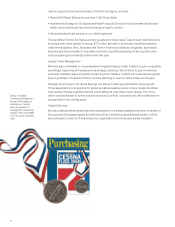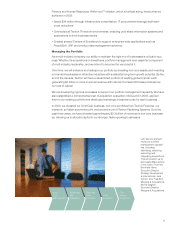E-Z-GO 2003 Annual Report Download - page 20
Download and view the complete annual report
Please find page 20 of the 2003 E-Z-GO annual report below. You can navigate through the pages in the report by either clicking on the pages listed below, or by using the keyword search tool below to find specific information within the annual report.
18
Income from continuing operations was $281 million in 2003, compared with $367 million for 2002 and
$474 million in 2001. The decreases in 2003 and 2002 were primarily due to declines in segment profit.
Textron recorded certain items that affected the comparability of operating results in the last three years.
These items are summarized in the table below:
(In millions) 2002 2001
Special charges $ 159 $ 135 $ 143
Gain on sale of businesses (15) (25) (339)
144 110 (196)
Income tax expense (benefit) on above items (44) (28) 80
$ 100 $ 82 $ (116)
In addition to the special charges previously discussed, Textron also recognized gains on the sale of
Trim and related businesses. Textron recognized a pre-tax gain of $15 million on the sale of its remaining
interest in an Italian automotive joint venture to C&A in 2003 and a $25 million pre-tax gain in 2002 from
transactions related to the divestiture of Trim. In 2001, Textron recorded a $339 million gain on the sale of
Automotive Trim to C&A.
A reconciliation of the federal statutory income tax rate to the effective income tax rate is provided
below:
2002 2001
Federal statutory income tax rate 35.0% 35.0% 35.0%
Increase (decrease) in taxes resulting from:
State income taxes 2.4 1.8 1.4
Non-tax deductibility of goodwill amortization — — 2.9
Permanent items from Trim divestiture — 1.3 1.4
Favorable tax settlements (3.2) (2.2) —
ESOP dividends (2.3) (3.2) —
Foreign tax rate differential (1.6) (0.2) (0.5)
Export sales benefit (1.4) (1.5) (1.5)
Other, net (2.2) (0.4) (2.5)
Effective income tax rate 26.7% 30.6% 36.2%
In 2004, Textron does not expect the favorable tax settlements to recur, resulting in an expected effec-
tive tax rate of approximately 30%.
In the third quarter of 2003, Textron sold certain assets and liabilities related to its remaining OmniQuip
business to JLG Industries, Inc. for $90 million in cash and a $10 million promissory note that was paid in
full in February 2004. In the fourth quarter of 2003, Textron Financial sold substantially all of its small
business direct portfolio to MBNA America Bank, N.A. for $421 million in cash. Textron has reclassified
the aggregate financial results of these businesses and all the previously sold OmniQuip businesses as
discontinued operations.
During 2002, Textron recorded an after-tax transitional impairment charge of $488 million upon the
adoption of SFAS No. 142, “Goodwill and Other Intangible Assets.” Under this Statement, goodwill and
certain assets with indefinite lives are no longer amortized and must be tested for impairment annually.
In 2001, reported pro forma net income excluding amortization of goodwill was $254 million, or $1.78
per diluted share.
The after-tax impairment charge relates to the following segments: $385 million in Industrial, $88 million
in Fastening Systems and $15 million in Finance. For the Industrial and Fastening Systems segments,
the primary factor resulting in the impairment charge was the decline in demand in certain industries in
which these segments operate, especially the telecommunications industry, due to the economic slow-
down. The Finance segment’s impairment charge related to the franchise finance division and was pri-
marily the result of decreasing loan volumes and an unfavorable securitization market.
























